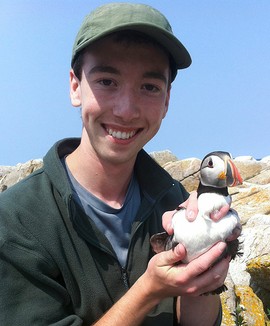
We would like to congratulate our April eBirder of the month, Benjamin Van Doren. Benjamin is a high school student from White Plains, New York, who will be attending Cornell University in the fall. We met Benjamin at our first annual Young Birders Event. During this event he expressed a particular interest in migration and flight calls and developed an ambitious project to gather morning flight data from dozens birdwatchers in the Northeast. Participants recorded all birds seen in flight for the first two hours of the day and recorded the direction of flight for every individual bird. These were entered into a spreadsheet, with programming that formatted the data for Benjamin’s database and also ran an automated script that prepared an upload for eBird. He compiled and compared all these data with meteorological, radar, and flight call data to examine the dynamics and causes of the morning flight phenomenon. For this work, Benjamin won 5th place in the prestigious Intel Science Talent Search. In addition to his research, Benjamin created the Westchester County, New York filter and is our eBird reviewer for that region. It probably goes without saying that he is also a very capable eBirder who has entered over one thousand checklists.
Residence: White Plains, New York
Years eBirding: 9
eBird Life List: 619
Number of eBird Locations: 538
Number of eBird
Checklists: 1187
From Benjamin:
For as long as I’ve been a birder, I’ve been a citizen
scientist. It began in the winter of 2002-2003. I was a third-grader
staring out the large windows of my classroom at all the birds flocking
to snow-encrusted feeders. I fondly remember those feeder-watching
days, when I was first introduced to the parallel universe of bird.
Each bird was an enigma, its identity only discernable by someone with
the requisite knowledge. There was (as there still is!) the possibility
of the exciting or unexpected, such as the occasional Chipping Sparrow
or, rarely, a flash-by Sharp-shinned Hawk. My class was taught not only
how to identify these visitors, but to tally numbers, record high
counts, and take temperature and weather readings. Proud of ourselves,
we then submitted the data we had collected to—of course—ornithologists
at the Cornell Lab of Ornithology. Our sightings weren’t just fun to
collect, they would be put to use for the betterment of the
birds.
I had bird feeders at my house by spring. My first eBird
checklist dates from the following winter (the others had been Project
FeederWatch). I’m one of the lucky ones who can say that my whole life
list is in eBird. Partly because of my love of birds, partly because I
understand and appreciate the value and need to create as complete a
picture as possible of where, when, and why birds do what they do, I
eBird often. I grew up hearing older birders lament the loss of a
habitat or the decrease of a population; today, I witness as acutely as
ever the decline, endangerment and extirpation of so many species
locally and worldwide. One person alone may have difficulty making a
resounding difference, but many people, working together and
contributing to a worthwhile endeavor—this, I am sure, can have an
impact.
For years, I’ve been fascinated by bird migration. I find
amazing the feats that some species have evolved: the weeklong, nonstop
flight from Alaska to New Zealand that Bar-tailed Godwits undertake
each fall or that albatrosses can cross entire oceans expending
marginally more energy than they do sitting still. Different, but
equally impressive, are the migrations of our Neotropical migrants,
many of which densely populate their breeding grounds to exploit an
explosion of food in the spring, and completely vacate the continent in
fall. I decided to explore this further to conduct a study on
morning flight migration, taking advantage of a science research
program at my high school, the insightful guidance of Cornell
researcher (and current BirdCaster) Andrew Farnsworth, and the generous
support of a number of volunteers. I first met Andrew at the annual
Cornell Young Birders Event, a great program run annually by the Lab. I
find morning flight to be a particularly intriguing behavior, as birds
that are typically nocturnal migrants set out in the early morning in
directions that often bring them further away from their
ultimate destinations. To gain insight into why this occurs, I compared
morning flight observations with a number of measures of weather
(winds, frontal passages, high pressure) and nocturnal migration
(Doppler radar, flight calls). To ensure that these data are preserved
and available, I developed my spreadsheets so that they would generate
an eBird checklist for every 15-minute interval of observation (which
came out to about 600 checklists). One of my major findings was that
many migrants in morning flight seem to be correcting for nightly wind
drift as they move further inland at dawn, confirming theories.
Interestingly, this pattern didn’t necessarily hold true for inland
locations, suggesting that migrants near the coast fly in these
atypical directions at least in part to avoid being pushed out to sea
on subsequent nights. However, future research is definitely
needed.
Earlier this year, I was surprised and honored when I
found out I had been named a finalist in the Intel Science Talent
Search, a national competition for high school students who have
conducted science research. Among many very cool events during our
all-expenses-paid week in Washington, D.C., we were fortunate enough to
meet President Obama, who talked to us about the importance of science
education and congratulated us on our achievements. It was a surreal
and inspiring experience, and I ended up placing fifth overall in the
competition!
I thank the Cornell Lab of Ornithology and eBird for
providing me with some of the tools and opportunities through which
I’ve developed a love for science. I highly recommend that any high
school student (or anyone, for that matter!) who is interested in
science research pursue it.
